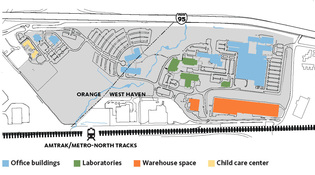 loading
loading
Light & VerityWest Campus gets its own VP Mark Zurolo ’01MFAThe 136-acre West Campus includes 17 buildings, acres of parking, and open space. View full imageYale's purchase of the Bayer HealthCare corporate campus last year provided the university with 136 acres of land, 17 buildings, and more than 500,000 square feet of state-of-the-art research laboratory space in the nearby towns of West Haven and Orange. But the most important acquisition was something less tangible: the chance to turn Yale into a world leader in the biomedical sciences. Now, administrators just have to figure out how. "It's just a total windfall for the university," says Yale biologist Michael Donoghue. "Now the challenge is to be very creative about building it up and how we can use it to our best advantage." One of the first steps was taken in August, when Donoghue was appointed to a new officer-level position: Vice President for West Campus Planning and Program Development. "The idea is to try to do spectacular things that we couldn't do on the main campus." The guiding principle for the West Campus is that it should be home to programs that are "transformative" for the university -- not merely a place for current faculty to spread out. "The fundamental idea is to try to do spectacular things that we couldn't do on the main campus," says Donoghue, a professor of ecology and evolutionary biology who recently finished a five-year term running the Peabody Museum of Natural History. Donoghue was appointed to the vice presidency for three years, during which he will be responsible for developing and executing a vision for the West Campus. Many of the West Campus buildings were originally designed for drug development, which makes them suitable homes for new biomedical research programs. "A surprising amount of the space is excellent," Donoghue says. "Many of the science buildings are essentially brand new, and they even come with a substantial amount of equipment in place." Robert Alpern, dean of the School of Medicine, says that there is particular interest in developing research centers for cancer biology, microbial diversity, and drug discovery, though final decisions have not yet been made. They will depend in part upon what scientific superstars can be recruited. Yale has already hired James Rothman ’71, a prominent cell biologist, away from Columbia to head the new Center for High-Throughput Cell Biology on the West Campus. Rothman, an award-winning researcher, specializes in membrane transport. The university is also beginning to turn part of the property into what it is calling a "collections campus." This plan will provide Yale's museums, galleries, and libraries with more space for their holdings and allow them to develop new programs, says Donoghue. Some staff from the cell biology group and the Peabody Museum have already moved into the West Campus. But with few plans finalized, there's still plenty of time left to brainstorm, and Donoghue says he's excited by the possibilities. "When people realize what this opportunity really looks like," he says, "they'll be astounded."
The comment period has expired.
|
|